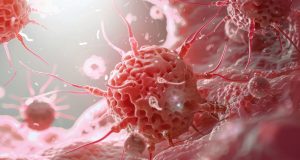Researchers at Weill Cornell Medicine harnessed the power of AI and machine learning technologies to develop a more effective model for predicting how patients with muscle-invasive bladder cancer will respond to chemotherapy. The model leverages whole-slide tumor imaging data and gene expression analysis in a way that outperforms previous models that use only a single type of data. The study, published in npj Digital Medicine, identifies key genes and tumor characteristics that may determine treatment success. The ability to accurately predict how an individual will respond to the standard of care treatment for this malignant cancer can help doctors personalize treatment and could potentially spare people who respond well to treatment from having their bladder removed.
Better Model, Better Predictions in Bladder Cancer
“This work exemplifies the spirit of precision medicine,” said Dr. Fei Wang, professor of population health sciences at Weill Cornell Medicine and founding director of the Institute for Artificial Intelligence for Digital Health, who co-leads the study. ‘We aim to identify the right treatment for the right patient at the right time,’ added Dr. Bishoy Morris Faltas, who co-leads the study. He is the Gellert Family-John P. Leonard MD Research Scholar in Hematology and Medical Oncology, as well as an associate professor of medicine and cell and developmental biology at Weill Cornell Medicine and an oncologist at NewYork-Presbyterian/Weill Cornell Medical Center. Dr. Zilong Bai, research associate in population health sciences, and Dr. Mohamed Osman, post-doctoral fellow in medicine, of Weill Cornell Medicine co-led this work.
The two lead investigators teamed up to create a better predictive model. While Dr. Wang’s lab focuses on data mining and cutting-edge machine learning analysis, Dr. Faltas is a physician-scientist with expertise in bladder cancer biology. They drew on data from the SWOG Cancer Research Network, which designs and conducts multicenter clinical trials for adult cancers. Specifically, the researchers integrated data from images of dissected tumor samples with gene expression profiles, which provide a snapshot of the “switched on” or “switched off” genes. Since the expression patterns alone were not sufficient to predict patient responses in previous studies, they decided to include more information in their model.
To analyze the images, the researchers used specialized AI methods called graph neural networks that capture how cancer cells, immune cells, and fibroblasts are organized in the tumor and interact with each other. They also performed automated image analysis to identify these different cell types at the tumor site. Combining the image-based inputs with the gene expression data to train and test their AI-driven deep learning model led to better clinical response predictions than models that used only gene expression or imaging. ” On a scale of 0 to 1, where 1 is perfect and 0 means nothing is correct, our multimodal model is close to 0.8, while unimodal models that rely on only one source of data can achieve about 0.6,” Dr. Wang said. ”That’s already exciting, but we plan to optimize the model for further improvements.”
Give Patients a Score that Predicts How They Will Respond to a Given Therapy
In the search for biomarkers, such as genes that can predict clinical outcomes, the researchers are finding clues that make sense. They could see that some of the genes they know are biologically relevant, not just random genes. The researchers plan to feed other types of data into the model, such as mutation analysis of tumor DNA that can be detected in blood or urine, or spatial analysis that would allow more precise identification of the cell types present in the bladder. That’s one of the most important findings of the study – that the data work together to improve prediction.
The model also provided some new hypotheses that Dr. Faltas and Dr. Wang want to explore further. For example, the ratio of tumor cells to normal tissue cells, such as fibroblasts, has implications for predicting response to chemotherapy. It is possible that a high number of fibroblasts can protect tumor cells from chemotherapy drugs or promote the growth of cancer cells. The researchers plan to work to validate their findings in other clinical trial cohorts. They are open to expanding their collaboration to see if their model can predict therapeutic response in a broader patient population. “The dream is that patients come into my office and I can put all of their data into the AI system and give them a score that predicts how they would respond to a given therapy,” Dr. Faltas said. “This is going to happen. But doctors like me will need to learn how to interpret those AI predictions and know that I can trust them – and be able to explain them to my patients in a way that they can also trust.”






